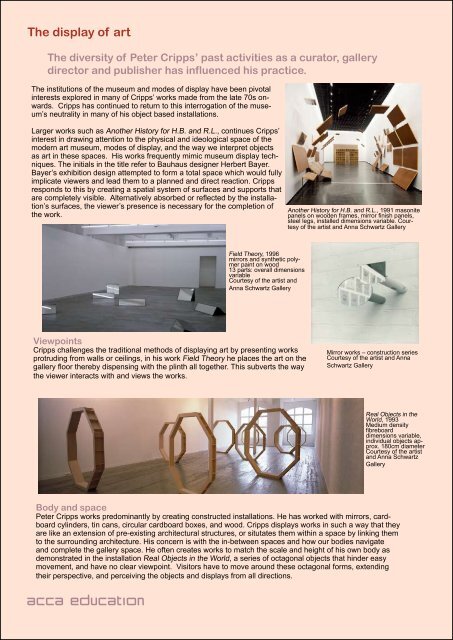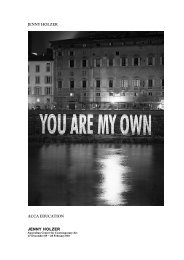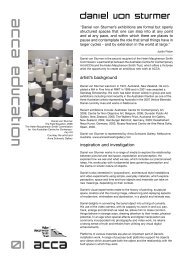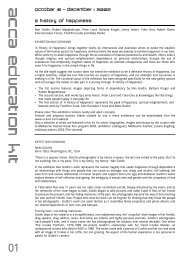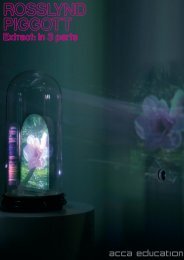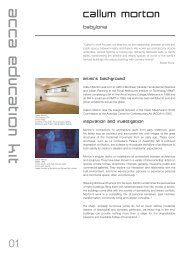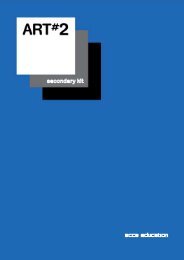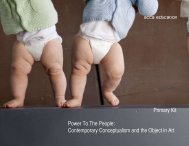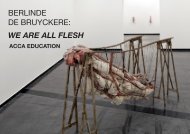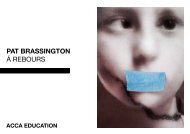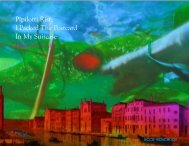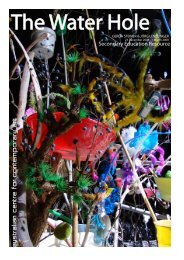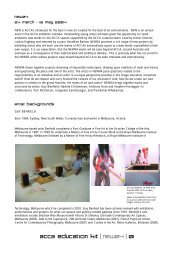Peter Cripps towards an elegant solution - ACCA
Peter Cripps towards an elegant solution - ACCA
Peter Cripps towards an elegant solution - ACCA
You also want an ePaper? Increase the reach of your titles
YUMPU automatically turns print PDFs into web optimized ePapers that Google loves.
The display of art<br />
The diversity of <strong>Peter</strong> <strong>Cripps</strong>’ past activities as a curator, gallery<br />
director <strong>an</strong>d publisher has influenced his practice.<br />
The institutions of the museum <strong>an</strong>d modes of display have been pivotal<br />
interests explored in m<strong>an</strong>y of <strong>Cripps</strong>’ works made from the late 70s onwards.<br />
<strong>Cripps</strong> has continued to return to this interrogation of the museum’s<br />
neutrality in m<strong>an</strong>y of his object based installations.<br />
Larger works such as Another History for H.B. <strong>an</strong>d R.L., continues <strong>Cripps</strong>’<br />
interest in drawing attention to the physical <strong>an</strong>d ideological space of the<br />
modern art museum, modes of display, <strong>an</strong>d the way we interpret objects<br />
as art in these spaces. His works frequently mimic museum display techniques.<br />
The initials in the title refer to Bauhaus designer Herbert Bayer.<br />
Bayer’s exhibition design attempted to form a total space which would fully<br />
implicate viewers <strong>an</strong>d lead them to a pl<strong>an</strong>ned <strong>an</strong>d direct reaction. <strong>Cripps</strong><br />
responds to this by creating a spatial system of surfaces <strong>an</strong>d supports that<br />
are completely visible. Alternatively absorbed or reflected by the installation’s<br />
surfaces, the viewer’s presence is necessary for the completion of<br />
the work.<br />
Another History for H.B. <strong>an</strong>d R.L., 1991 masonite<br />
p<strong>an</strong>els on wooden frames, mirror finish p<strong>an</strong>els,<br />
steel legs, installed dimensions variable. Courtesy<br />
of the artist <strong>an</strong>d Anna Schwartz Gallery<br />
Field Theory, 1996<br />
mirrors <strong>an</strong>d synthetic polymer<br />
paint on wood<br />
13 parts: overall dimensions<br />
variable<br />
Courtesy of the artist <strong>an</strong>d<br />
Anna Schwartz Gallery<br />
Viewpoints<br />
<strong>Cripps</strong> challenges the traditional methods of displaying art by presenting works<br />
protruding from walls or ceilings, in his work Field Theory he places the art on the<br />
gallery floor thereby dispensing with the plinth all together. This subverts the way<br />
the viewer interacts with <strong>an</strong>d views the works.<br />
Mirror works – construction series<br />
Courtesy of the artist <strong>an</strong>d Anna<br />
Schwartz Gallery<br />
Real Objects in the<br />
World, 1993<br />
Medium density<br />
fibreboard<br />
dimensions variable,<br />
individual objects approx.<br />
180cm diameter<br />
Courtesy of the artist<br />
<strong>an</strong>d Anna Schwartz<br />
Gallery<br />
Body <strong>an</strong>d space<br />
<strong>Peter</strong> <strong>Cripps</strong> works predomin<strong>an</strong>tly by creating constructed installations. He has worked with mirrors, cardboard<br />
cylinders, tin c<strong>an</strong>s, circular cardboard boxes, <strong>an</strong>d wood. <strong>Cripps</strong> displays works in such a way that they<br />
are like <strong>an</strong> extension of pre-existing architectural structures, or situtates them within a space by linking them<br />
to the surrounding architecture. His concern is with the in-between spaces <strong>an</strong>d how our bodies navigate<br />
<strong>an</strong>d complete the gallery space. He often creates works to match the scale <strong>an</strong>d height of his own body as<br />
demonstrated in the installation Real Objects in the World, a series of octagonal objects that hinder easy<br />
movement, <strong>an</strong>d have no clear viewpoint. Visitors have to move around these octagonal forms, extending<br />
their perspective, <strong>an</strong>d perceiving the objects <strong>an</strong>d displays from all directions.<br />
acca education


